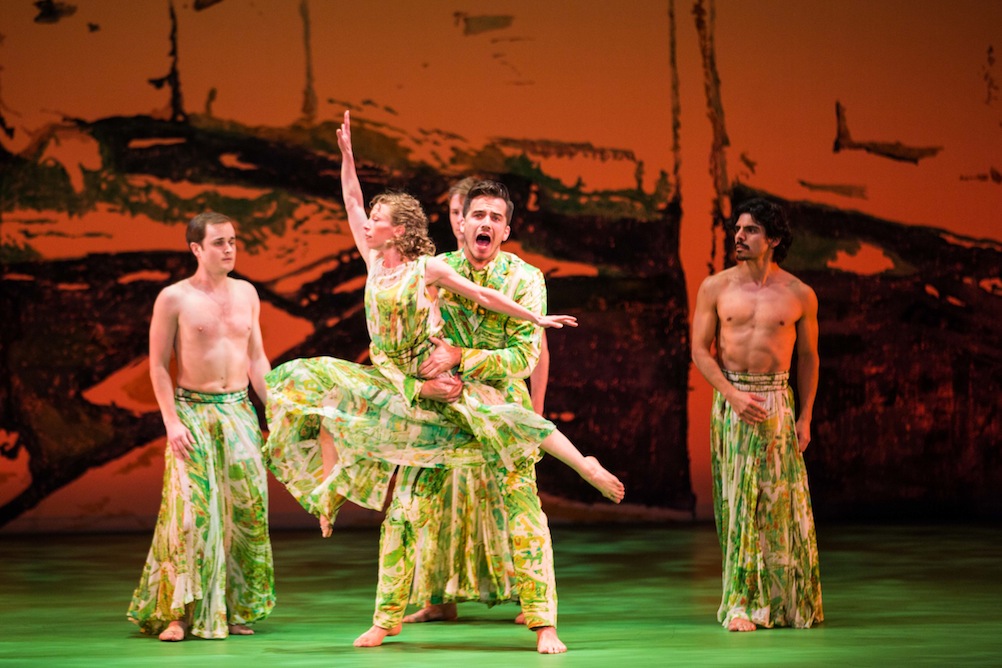Mark Morris brings elemental new life to Handel’s “Acis and Galatea”
“Something old, something new” described Thursday’s performance of Handel’s Acis and Galatea, performed by the Mark Morris Dance Group and the Handel & Haydn Society. The production, presented by the Celebrity Series of Boston, started its two-year tour in California last month and runs at the Shubert Theatre until May 18.
Morris is no doubt one of the most celebrated and sought after choreographers of the day. His past experience in melding dance with opera (Acis marks the 12th such venture) highlights Morris’s keen, almost uncanny ability to weave the dancing into the musical score with natural balancing that makes the gestures and motions seems as elemental to the musical moment as the pitches and harmonies.
The inherent musicality of dance gesture, was most effective in Acis because it was most necessary. Acis and Galatea, written by Handel in 1718 (and performed here in Mozart’s 1788 orchestration) is not an opera but rather more of a masque, an art form with its roots in the Middle Ages. As did Mozart, Morris added his own touches to modernize the work and keep it relevant, while retaining its core simplicity and balance.
The plot is a mythological love triangle involving a nymph, a shepherd, and a Cyclops, but it is the music and dance that is meant to hold the attention, not the scenario.
If the theme of the evening was the melding of old a new, it succeeded definitively. Failing to have everyone in their seat by the curtain, poor air circulation and dim lighting inadvertently gave us all the noise, sweat and tears of what could have been a performance in the 17th-century. A squeaky chair temporarily made Galatea’s vulnerable “Hush!” aria seem comedic when it squeaked a solo during a pregnant pause, on a note so fitting many thought the sound came from the pit.
The vocal cast of four was well versed in early music styles. Sherezade Panthaki soared effortlessly as Galatea, and Thomas Cooley gave an equally capable performance of Acis her lover. Zach Finkelstein sang Damon – an awkward, somewhat shoehorned-in character – with sensitivity and grace, and the characters had good chemistry displayed within the confines of the artistic style. The show was of course stolen by Polyphemus, the antagonistic monster sung admirably by bass-baritone Douglas Williams, who devoured his role and relished in dominating this world of nymphs and shepherds.
The dancers sported gauzy costumes that harmonized with the abstract but halcyon backdrops. Costume designer Issac Mizrahi placed the female dancers in wispy ankle-length dresses that matched the backdrops, and the shirtless males in similar skirts.
In pairs, quartets, solo or with the whole company, the dancers spun continuously throughout the performance. When the chorus started Act I, dancers set the stage as breeze-kissed trees and bubbling brooks. As Galatea sang “Hush, ye pretty warbling choir!” they went through a series of steps which later became evident was a dance-fugue, or at least a polyphonic (polypedal?) canon. The dancers executed multiple diverse motions, some classic, some modern, all to the music and with some significance to the dramatic moment.
Some in the audience found some of the modern moves a bit humorous, but the real comedy in Morris’ interpretation was yet to come. As Damon declares “See how thy flocks in yonder valley stray,” a dutiful flock of dancer-sheep merrily prance across the stage, with one delightfully breaking the fourth wall with a quick and quirky glance to the audience. The final chorus of Act I, “Happy We,” which was as ridiculous as it sounds (think “Every Valley” on a sugar rush) had dutifully ridiculous choreography, echoing Handel’s music at every turn, and never taking itself too seriously.
When Act II opens in a minor key, we know the plot has shifted. Dancers congregate in threes, not pairs – two men to a woman, subtly displaying the story’s central conflict. Morris here draws on many styles, including Irish step and even some techno, but this polystylism aids the atmosphere and advances the plot. Characteristic dance moves return like musical themes and are recognized as plot-significant gestures. Like a stained glass window, they are driving home the point wordlessly.
There are no sets but Adrianne Lobel’s abstract and subtle backdrops likewise share a continuity with the musical score. When Acis is killed, the chorus sings a capella and the backdrop disappears, and we feel the abandonment and loneliness of Galatea. But as she sings of her power to bring his spirit back as a rushing stream, the dancers gradually, subtly, move from spirits of consolation to the bubbling waters, embracing Galatea.
The period-instrument orchestra (including fortepiano) performed beautifully under the direction of Nicholas McGegan, although the horns needed a few bars at the start of each act to find their footing. Mozart’s orchestration was clear and transparent, even under the balcony, and the idea of having the five-part chorus perform offstage was inspired. In this production, the dancers embodied many roles, not the least of which is that usually held by the chorus – commentator, sounding board, characters’ subconscious.
Acis and Galatea runs at the Shubert Theater through May 18. celebrityseries.org
Patrick Valentino, a graduate of New England Conservatory, is a conductor, composer, instrumentalist, and writer living and working in the Boston area. He has previously written reviews and articles for Performing Arts of New England and the Ithaca Times, among other publications. More information can be found at PatrickValentinoMusic.com
Posted in Performances




